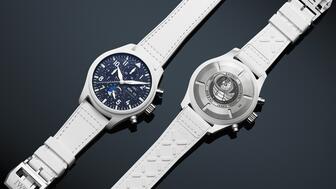US Bans Import of Russian Diamonds
The Jewelers Vigilance Committee has shared updated guidance on the executive order, which was issued Friday.

Washington, D.C.—President Joe Biden issued an executive order Friday, March 11, banning the import of non-industrial Russian diamonds into the United States.
It’s the latest from the U.S. government in response to Russia’s Feb. 24 invasion of Ukraine.
On Feb. 25, the U.S. put both diamond miner Alrosa and its CEO on a list of sanctions, though it didn’t directly prohibit buying the company’s diamonds. This new order now means no direct diamond buying from Alrosa or any other Russian company is allowed.
Alrosa mined 32.4 million carats in 2021, making it the largest producer by volume and accounting for nearly 30 percent of global supply, with sales topping $4 billion. The Russian government holds a 33 percent stake in the company.
The Jewelers Vigilance Committee said Friday any U.S. business purchasing diamonds directly from Alrosa, Alrosa USA, or any other Russian company should immediately put an end to the transactions.
JVC noted early Monday the ban on importation of diamonds from Russia includes “unworked or simply sawn, cleaved, or bruted” diamonds, meaning rough diamonds, as well as those cut and polished in Russia.
U.S. Customs regulations and interpretation of the FAQs issued by the Department of the Treasury’s Office of Foreign Assets Control after the ban was enacted indicate rough diamonds from Russia that are cut and polished in another country are “substantially transformed” by that process, JVC said, and thereby become a product of that country.
This means rough diamonds imported from Russia into a country that hasn’t placed sanctions or a ban on the diamonds are then legal to import to the U.S. as they fall under a different tariff code.
In additional guidance issued Monday, JVC said it is possible countries that serve as traditional cutting centers might implement a ban on the import of Russian diamonds.
The U.S. government also could decide to further limit imports of products originating in Russia that are “substantially transformed” somewhere else or add additional tariff codes to the current ban.
JVC said it recommends the trade proceed with “extreme caution” when it comes to diamond imports as the risk of additional limits in the future is high.
The organization also urges U.S. businesses to make sure their anti-money laundering programs are active and to check OFAC’s sanction lists to make sure they’re not sourcing products from places or companies they shouldn’t be.
Friday’s executive order also prohibits “the exportation, re-exportation, sale, or supply, directly or indirectly, from the United States” of luxury goods to Russia.
JVC said this means U.S. businesses previously selling jewelry to or in Russia should stop doing so immediately.
Other Russian goods banned for import by the order are fish, seafood, and alcoholic beverages.
The Latest

Said to be the first to write a jewelry sales manual for the industry, Zell is remembered for his zest for life.

The company outfitted the Polaris Dawn spaceflight crew with watches that will later be auctioned off to benefit St. Jude’s.

A buyer paid more than $100,000 for the gemstone known as “Little Willie,” setting a new auction record for a Scottish freshwater pearl.

Supplier Spotlight Sponsored by GIA.

Anita Gumuchian created the 18-karat yellow gold necklace using 189 carats of colored gemstones she spent the last 40 years collecting.


The giant gem came from Karowe, the same mine that yielded the 1,109-carat Lesedi La Rona and the 1,758-carat Sewelô diamond.

The three-stone ring was designed by Shahla Karimi Jewelry and represents Cuoco, her fiancé Tom Pelphrey, and their child.

Supplier Spotlight Sponsored by GIA

The Manhattan jewelry store has partnered with Xarissa B. of Jewel Boxing on a necklace capsule collection.

Acting as temporary virtual Post-it notes, Notes are designed to help strengthen mutual connections, not reach new audiences.

The jewelry historian discusses the history and cultural significance of jewelry throughout time and across the globe.

From fringe and tassels to pieces that give the illusion they are in motion, jewelry with movement is trending.

The designer and maker found community around her Philadelphia studio and creative inspiration on the sidewalks below it.

The change to accepted payment methods for Google Ads might seem like an irritation but actually is an opportunity, Emmanuel Raheb writes.

The industry consultant’s new book focuses on what she learned as an athlete recovering from a broken back.

The fair will take place on the West Coast for the first time, hosted by Altana Fine Jewelry in Oakland, California.

Hillelson is a second-generation diamantaire and CEO of Owl Financial Group.

Submissions in the categories of Jewelry Design, Media Excellence, and Retail Excellence will be accepted through this Friday, Aug. 23.


Known as “Little Willie,” it’s the largest freshwater pearl found in recent history in Scotland and is notable for its shape and color.

Clements Jewelers in Madisonville cited competition from larger retailers and online sellers as the driving factor.

The gemstone company is moving to the Ross Metal Exchange in New York City’s Diamond District.

Most of the 18th century royal jewelry taken from the Green Vault Museum in Dresden, Germany, in 2019 went back on display this week.

The Pittsburgh jeweler has opened a store in the nearby Nemacolin resort.

With a 40-carat cabochon emerald, this necklace is as powerful and elegant as a cat.

The Erlanger, Kentucky-based company was recognized for its reliability when it comes to repairs and fast turnaround times.

Unable to pay its debts, the ruby and sapphire miner is looking to restructure and become a “competitive and attractive” company.

The trend forecaster’s latest guide has intel on upcoming trends in the jewelry market.




























